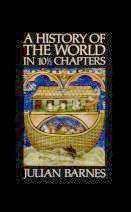A History of the World in 10½ Chapters
 First edition | |
| Author | Julian Barnes |
|---|---|
| Country | United Kingdom |
| Language | English |
| Publisher | Jonathan Cape (United Kingdom), Alfred A. Knopf (United States), Knopf Canada (Canada) |
Publication date | October 7, 1989 (United States) |
| Media type | Print (Hardcover) |
| Pages | 307 |
| ISBN |
0-224-03190-2 (First Edition) ISBN 0-394-58061-3 (First American Edition) ISBN 0-394-22121-4 (First Canadian Edition) |
| OCLC | 8569817 |
| 823.914 | |
| LC Class | PR6052.A6657 |
| Preceded by | Staring at the Sun |
| Followed by | Talking It Over |
A History of the World in 10½ Chapters is a novel by Julian Barnes published in 1989. It is a collection of short stories in different styles; however, at some points they echo each other and have subtle connection points. Most are fictional but some are historical.[1]
Background
One of the many recurrent motifs in the book is the portrayal of ships. This alludes to Noah's Ark — the subject of the first chapter — which plays a dominant role in the Abrahamic religions as an example of God's judgment. The woodworm who narrates the first chapter questions the wisdom of appointing Noah as God's representative. The woodworm is left out of the ark, just like the other "impure" or "insignificant" species; but a colony of woodworms enters the ark as stowaways and they survive the Great Deluge. The woodworm becomes one of the many connecting figures, appearing in almost every chapter and implying processes of decay, especially of knowledge and historical understanding.
Plot
Chapter 1, "The Stowaway" is an alternative account of the story of Noah's Ark from the point of view of the woodworms, who were not allowed onboard and were stowaways during the journey.
Chapter 2, "The Visitors" describes the hijacking of a cruise liner, similar to the 1985 incident of the Achille Lauro.
Chapter 3, "The Wars of Religion" reports a trial against the woodworms in a church, as they have caused the building to become unstable.
Chapter 4, "The Survivor" is set in a world in which the Chernobyl disaster was "the first big accident". Journalists report that the world is on the brink of nuclear war. The protagonist escapes by boat to avoid the assumed inevitability of a nuclear holocaust. Whether this occurred or is merely a result of the protagonist's paranoia is left ambiguous.
Chapter 5, "Shipwreck" is an analysis of Géricault's painting, The Raft of the Medusa. The first half narrates the historical events of the shipwreck and the survival of the crew members. The second half of the chapter analyses the painting itself. It describes Géricault's "softening" the impact of reality in order to preserve the aestheticism of the work, or to make the story of what happened more palatable.
Chapter 6, "The Mountain" describes the journey of a religious woman to a monastery where she wants to intercede for her dead father. The Raft of the Medusa plays a role in this story as well.
Chapter 7, "Three Simple Stories" portrays a survivor from the RMS Titanic, the Biblical story of Jonah and the whale, and the Jewish refugees on board the MS St. Louis in 1939, who were prevented from landing in the United States and other countries.
Chapter 8, "Upstream!" consists of letters from an actor who travels to a remote jungle for a film project, described as similar to The Mission (1986). His letters grow more philosophical and complicated as he deals with the living situations, the personalities of his costars and the director, and the peculiarities of the indigenous population, coming to a climax when his colleague is drowned in an accident with a raft.
The unnumbered half-chapter, "Parenthesis" is inserted between chapters 8 and 9. It is different in style to the other chapters, which are short stories; here a narrator addresses his readers and offers a philosophical discussion on love. The narrator is called "Julian Barnes", but, as he states, the reader cannot be sure that the narrator's opinions are those of the author. A parallel is drawn with El Greco's painting Burial of the Count of Orgaz, in which the artist confronts the viewer. The piece includes a discussion of lines from Philip Larkin's poem An Arundel Tomb ("What will survive of us is love") and from W. H. Auden's September 1, 1939 ("We must love one another or die").
Chapter 9, "Project Ararat" tells the story of a fictional astronaut Spike Tiggler, based on the astronaut James Irwin. Tiggler launches an expedition to recover what remains of Noah's Ark. There is overlap with chapter 6, "The Mountain."
Chapter 10, "The Dream" portrays New Heaven.
References
- ↑ Oates, Joyce Carol (1 October 1989). "But Noah Was Not a Nice Man". New York Times. Retrieved 6 June 2014.
External links
- Julian Barnes' Website, with extensive bibliography of translations and scholarly articles.
- Brian Finney Article
- The Search is All?: The Pursuit of Meaning in Julian Barnes’s Flaubert’s Parrot, Staring at the Sun and A History of the World in 10 ½ Chapters by Wojciech Drag